Ranking all 20 'The Royal Diaries' Books
The Real Princess Diaries
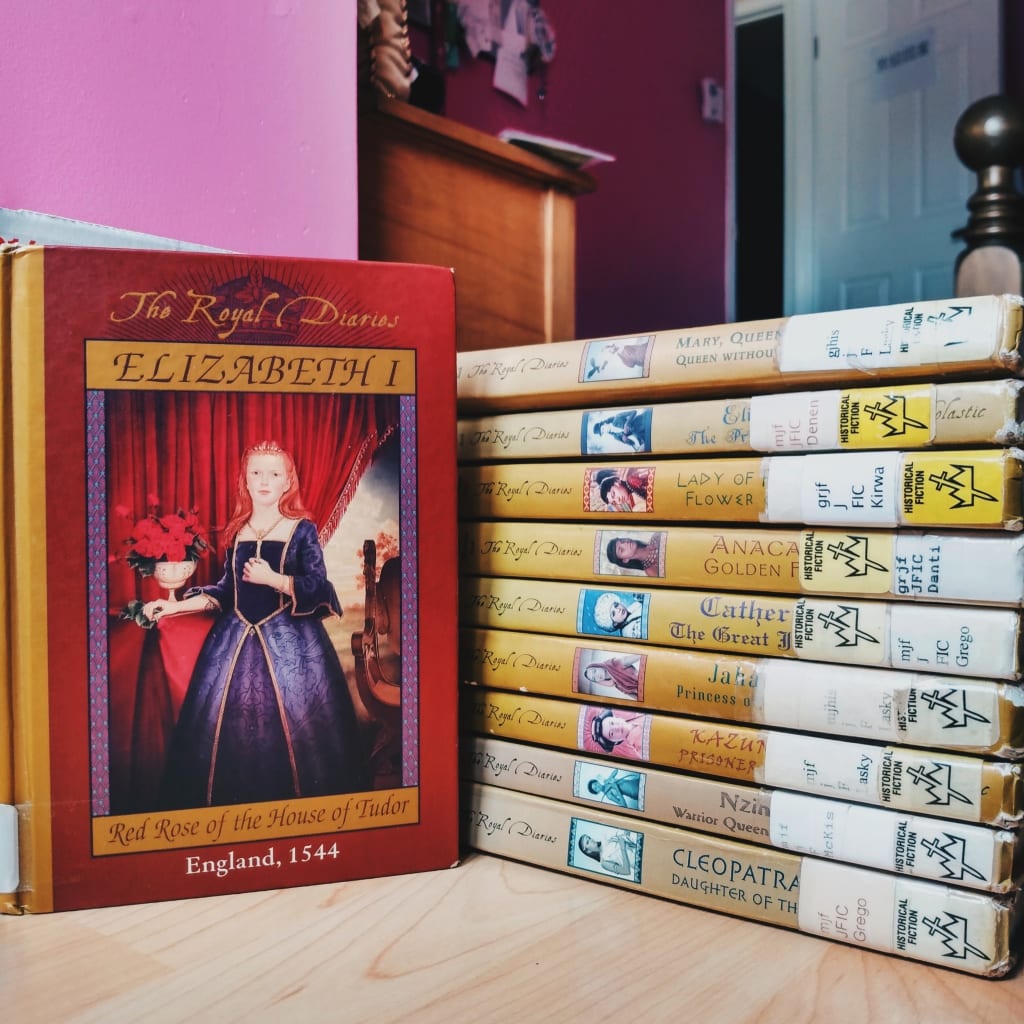
Since the dawn of time, well, 2018, when I started reading and ranking children's books (see here, here, and here), people have been clamouring for a Royal Diaries ranking. After enough peer pressure, it's finally time to put aside my anti-monarchist beliefs and give the people what they want.
While I found The Royal Diaries a little underwhelming, they're nevertheless enjoyable and educational. The biggest fault of the series is that because all the subjects are real people, the exposition tends towards clunkiness. Multiple books open with a paragraph along the lines of "My name is [x], Princess of [x]. My father is the mighty King [x] of [x]. We live at [x] palace. I was given this book by [x] to record my most private and important thoughts in this, the [x] year of my life". The plots are so formulaic that I mapped them into five different types, with a few notable exceptions.
I've tried to keep my own political beliefs out of the ranking, to a degree, but there are some cases where this is unavoidable. Neither history nor literature are apolitical. All opinions are my own. If you want to argue about my ranking, feel free to fight in my Twitter mentions. Now, onto the books!

20. Elisabeth: The Princess Bride, Austria-Hungary, 1853 by Barry Denenberg (2003)
Longtime fans will recall the epic highs and lows of my grudge against Barry Denenberg. One of his Dear America books made my top 5, while the rest made me want to put my head through a wall. We're back in the saddle this time with one of the worst 'diaries' I've ever read. Diary is in quotation marks because this book, a mere 93 pages of nothing, fails at the most basic tenet of epistolary fiction. Done correctly, the reader should understand the diarist on a cerebral level. The only thing in Sissi's head is dust. With cardboard dolls for characters, zero conflict, and all the emotion of a robot learning to love, Elisabeth is a travesty, even for Barry Denenberg. I'd call it a simple Wikipedia summary, but Wikipedia has strict editing and citing policies. Barry Denenberg can't even do rudimentary research! Elisabeth claims she has "absolutely no faculty for learning a foreign language". Not only does she use English in-universe, as a "secret language", but the actual Empress Elisabeth spoke German, Hungarian, Greek, French, and English! I feel like a suburban dad whose sports team just lost the Superbowl!

19. Jahanara: Princess of Princesses, India, 1627 by Kathryn Lasky (2002)
In the author's note, Kathryn Lasky admits that she "knew very little about Indian culture or history" before travelling to India for inspiration. It shows. It really shows. She also admits to making things up whole cloth, as it's a writer's job to imagine and interpret a setting. That's true, but when writing historical fiction, you're expected to do adequate research on your chosen subject! To make Jahanara relatable to the Girls of America, Lasky whitewashes her. Jahanara cheats during Ramadan because she's lazy and thinks that memorizing passages of the Koran is Wild Extremist Behaviour. That's not the end either. Jahanara gets a miniature of Elizabeth I and spends a third of the book obsessing over a dead white lady. When she falls in love (lust, actually), it's with the first white man she ever sees. The former has zero basis in history. As for the latter, Peter Mundy was a real-life writer and merchant with the East India Company. His only historical connection with Jahnara was a claim that she had a sexual relationship with her father! Great work, guys. Better than Elisabeth only because I can accurately call this a diary.
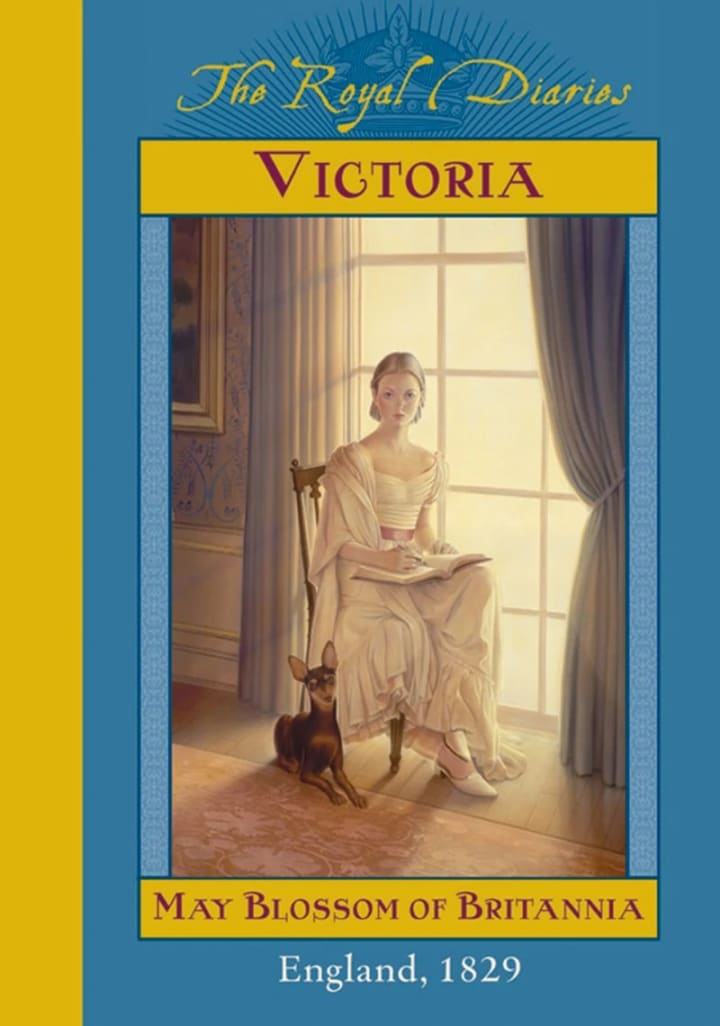
18. Victoria: May Blossom of Britannia, England, 1829 by Anna Kirwan (2001)
I imagine that reading Victoria in Canada in 2021 is a much different experience than reading it in 2001 would have been. One would hope that in 2021 a children's book about a colonialist, genocidal maniac as a precocious 9-year-old would be handled differently. Anna Kirwan's historical note owns up to the British Empire being brutal, racist, and blinded by its' own perceived superiority, then follows it up by saying that "Victoria's people" are still admired. The British Empire does not exist as it did in Victoria's time, but it's far from gone. Queen Elizabeth II is the legal owner of 1/6th of the earth's land surface and the head of 15 different countries in addition to her own. As long as Western media romanticizes the English crown, the ongoing consequences of English colonialism can be plausibly denied. Politics momentarily aside, Anna Kirwan has the most bananas writing style I've ever read. It's so dense and tries so hard to emulate a cheeky 1820s tone that it becomes incomprehensible. Compared to this book, actual Victorian literature is a breeze to parse.
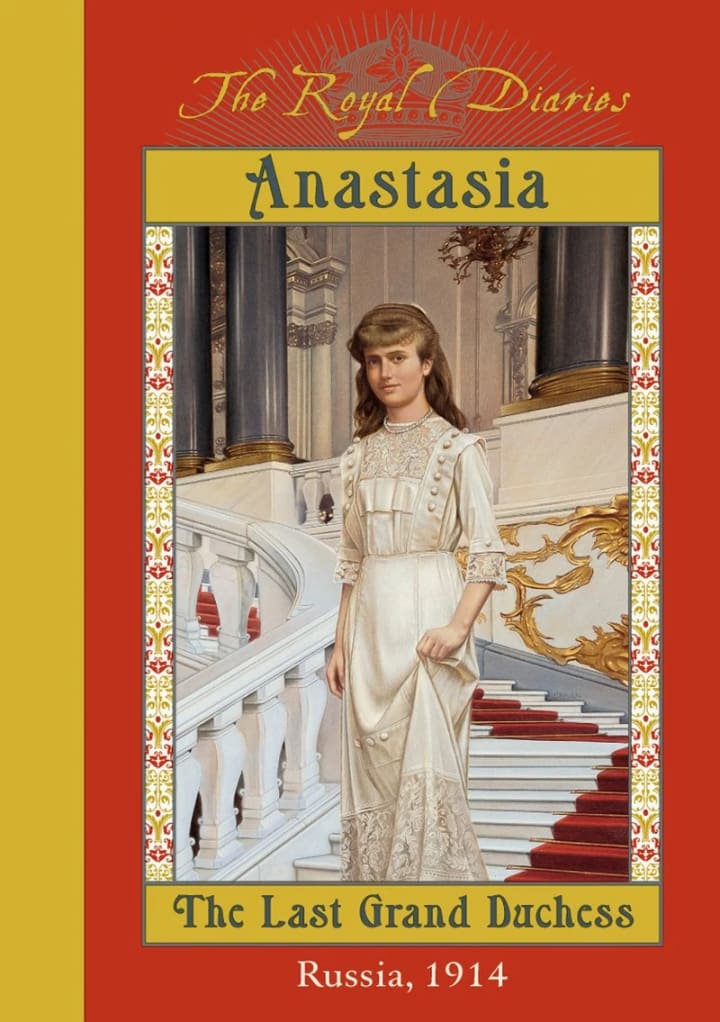
17. Anastasia: The Last Grand Duchess, Russia, 1914 by Carolyn Meyer (2000)
Everything about Anastasia is a mess. The cover portrait looks like Anastasia is on her way to meet her date for St. Petersburg's Imperial Junior Prom. The first 97 pages are one year, and the remaining 76 are four years!! I was bored to tears by this book, the writing of which can best be described as 'utilitarian'. While I understand that Scholastic in 2000 probably didn't want too much Commie Talk, the resulting book is shallow and nonsensical, a gross oversimplification of a complicated period in history. Where's the first Provisional Government? Nothing about the labour unrest? Alexander II was blown up 30 years prior; that could be fun foreshadowing! The pogroms don't even exist in the historical note. Every day is Out of Touch Thursday for this Grand Duchess. Children who read Anastasia are forgiven for thinking that the Romanovs got executed because people were mean to poor Alexandra and, uh oh! Tsar Nicky made some itty-bitty mistakes during such a stressful war. Are you really, really sure there weren't a few more factors at play, Carolyn Meyer? Show your small child Anastasia (1997), then give them a nonfiction book instead.

16. Kristina: The Girl King, Sweden, 1638 by Carolyn Meyer (2003)
This book reeks of Gender in the worst way. Now, if there's one thing Kristina's famous for, it's the debate re: her gender & sexuality. In the book, this manifests in terminal Not Like Other Girls Disease. Kristina disdains all girls and girly things except for Ebba Sparre, who is, you guessed it, Not Like Other Girls! Ebba is far less emotionally invested in their tepid friendship. I wasn't expecting a sensitive and nuanced take on historical queerness and gender non-conformity in 2003. That's not the problem. In fact, I probably would have been obsessed with this book if I'd read it as an unbearable closeted child. The problem is that Kristina herself is also an unbearable closeted child! She treats everyone around her like dirt, dismisses any feelings that aren't her own, and is so arrogant she's borderline delusional. And the prose is just as bad, wooden and uninspired. But the thing that bothers me is that Meyer's decision to present Kristina as a proto-feminist. The Kristina in this book definitely isn't, nor was historical Kristina. Maybe I'm projecting, but I don't think Kristina of Sweden wore mens' clothing for Subliminal Grl Pwr reasons. Sometimes, people are gender non-conforming for reasons that have nothing to do with being a girlboss, but Carolyn Meyer can't conceptualize that.
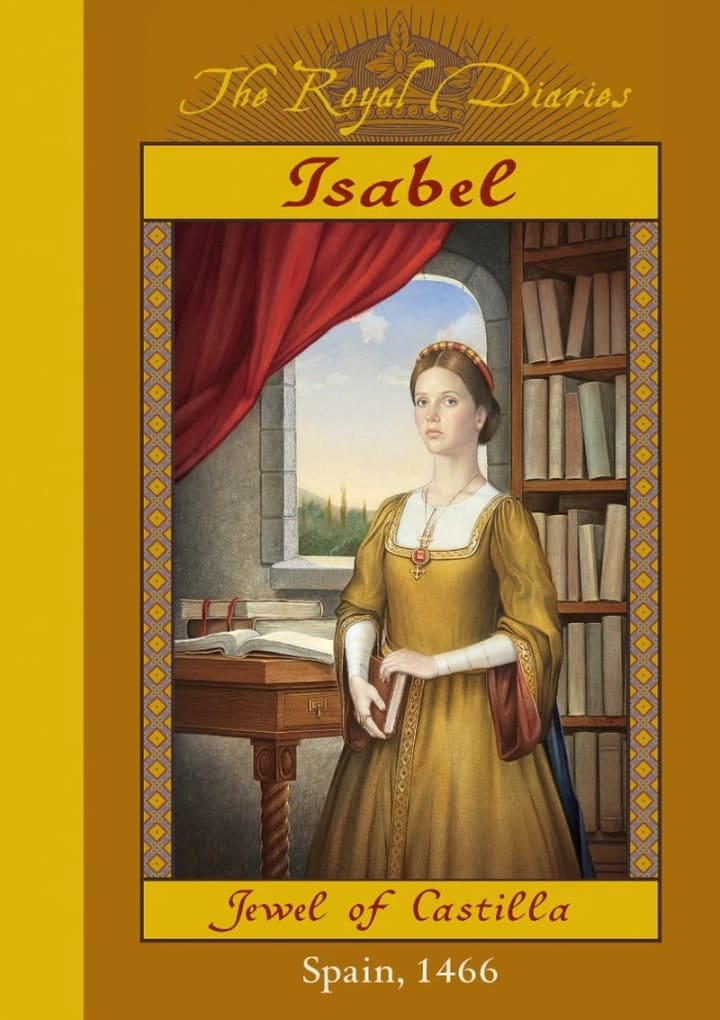
15. Isabel: Jewel of Castilla, Spain, 1466 by Carolyn Meyer (2000)
Like Victoria, Isabel deals with a narrator whose legacy is...complex. It scores better than Victoria because the prose isn't word salad. To her credit, Carolyn Meyer tries to interrogate Isabel's legacy of religious fanaticism and burning people. It doesn't entirely work, but she tries. Meyer invents a friend for Isabel named Catalina, whose ancestors were forcibly converted from Judaism to Christianity. Unfortunately, Isabel's religious paranoia means that she isn't much for friendship or tolerance. Catalina's assertion of her Christianity falls on deaf ears because Isabel is convinced that her family and the other conversos are carrying out secret Jewish rituals behind her back. The historical note gives a solid overview of Isabel's complicated reign and acknowledges the Jewish and Muslim diasporas she was responsible for. And then, Meyer immediately undoes her good points with a pro-Columbus slant. Isabel funded Columbus' voyage (thus enabling the murder of fellow Royal Diarist, Anacaona) but was definitely not on his side when she died. Now that the elephant in the room has safely tranquillized, I offer hearty kudos to any non-Catholic child who enjoys Isabel. The diary is first used so that Isabel has somewhere to record her sins and rarely lightens up.

14. Lady of Palenque: Flower of Bacal, Mesoamerica, A.D. 749 by Anna Kirwan (2004)
Lady of Palenque gets a bad reputation. With its 3.31/5 on Goodreads and a crushing 2.99/5 on Storygraph, it's the worst-rated by far. I'm getting on my soapbox to say that you guys have been too harsh on Lady of Palenque. Yes, the text gets too caught up in its quest for authenticity that it becomes tedious. Yes, I think this problem may have been remedied if it wasn't written by a white person. Yes, I still enjoyed it despite these faults. Lady of Palenque contains multitudes, and so do I. However, I am a 24-year-old with a history degree. I cannot imagine a child sitting down and trying to read it without a passing background on the subject matter. Anna Kirwan was an excellent researcher, but her writing skills were not up to the same calibre. Like Victoria, Lady of Palenque is researched to a fault. Each line is jam-packed with terminology and multiple names for the same characters like War and Peace: Maya Empire Edition. But a book being difficult doesn't mean it's irredeemable. Princess Green Jay has an engaging voice and a fun reason for keeping a diary. Most of the story follows a dangerous river journey wherein a guy steers a boat with a shark fin. The cover is a retina-scalding pink, and the May-December political marriage doesn't make my skin crawl. Lady of Palenque is worth a try, at least.
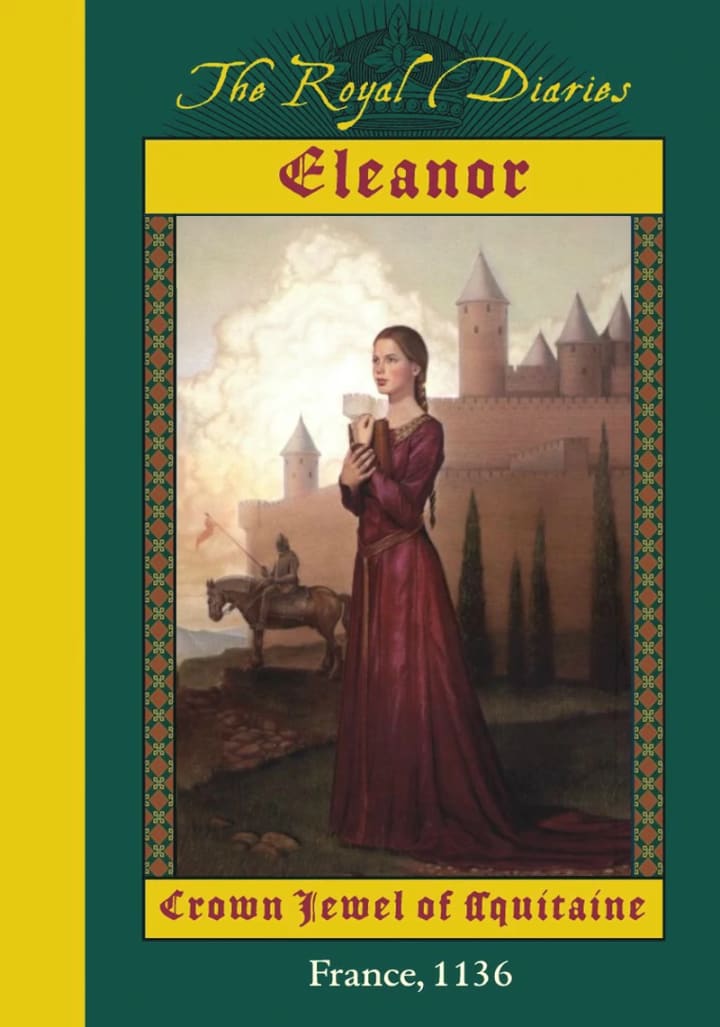
13. Eleanor: Crown Jewel of Aquitaine, France, 1136 by Kristiana Gregory (2002)
The pitfall of writing about the fictionalized childhoods of historical figures is that, often, their adult lives were far more fascinating. Such is the case of Eleanor of Aquitaine, Queen of England and France. She was known as much for her machinations as her marriages, the second of which was the possible inspiration for the Mountain Goats 7th studio album, Tallahassee, and gave rise to what I can only describe as Keeping Up With the Plantagenets. Eleanor was the most powerful woman in 12th-century Europe, yet her book left me lukewarm. The writing limps along, the courtly love lacks heart, and Eleanor herself swings between vaguely dreamy and slightly scheme-y. If there's one thing children love, it's the Middle Ages in all their gross, grandiose glory. So why does Eleanor feel more Medieval Times than Morte D'Arthur? The setting simply isn't deep enough, and Kristiana Gregory can't commit to swoon-worthy courtly love or perilous courtly intrigues. That said, Eleanor remains one of my favourite subjects in the series. Please enjoy this 25-second clip of Katharine Hepburn's portrayal of Eleanor that won her a third Oscar and did permanent damage to my psyche.

12. Elizabeth I: Red Rose of the House of Tudor, England, 1544 by Kathryn Lasky (1999)
The first Royal Diary is fun but unsteady! Elizabeth I is far too aware that it is dealing with Real History and that all the characters are Real Historical Figures, which leads to sentences like this: "[Mary's spies] are mostly Spanish. For her mother, Catherine of Aragon, was Spanish." It makes for awkward prose and, coupled with unnecessary repetition, gives children little credit for retaining basic historical information. Elizabeth herself is what you'd expect from an 11-year-old Elizabeth Tudor, which is to say that she's very academic, constantly in danger, and does some plotting. She's also incredibly lonely and traumatized after witnessing Catherine Howard's execution, which explains why she refuses to wed. Overall, Elizabeth I has a few rough patches, but I can understand why so many people loved it as children. It's generic but harmless.

11. Marie Antoinette: Princess of Versailles, Austria-France 1769 by Kathryn Lasky (2000)
In 10th grade, the trajectory of my life changed forever when I watched Tom Hooper's big-screen adaptation of Les Misérables, then read everything about the French Revolution that I got my grubby little hands on. Now, Les Mis didn't simply shape my political compass; it also made me an absolute nightmare to be around. It also meant that Marie Antoinette had to fight to win me over. The writing is insightful and, there's a lot to unpack about how Marie Antoinette's destiny as an empire meant she never got to be her own person. Lasky focuses less on Versailles and instead digs her teeth into the construction of a queen. This means the reader spends most of the novel waiting for her to get to Versailles with minimal payoff. But, all good things must come to an end, as must my praise. There are several typos, and one paragraph featured the same sentence twice in a row with different wording! If Scholastic took more care to edit these books, I wouldn't be calling them out. Also, Marie Antoinette relies too much on characters falling sick to spice up the plot. Hand to god, it happens every 10 pages or so. I stopped counting the number of illnesses and ailments.

10. Nzingha: Warrior Queen of Matamba, Angola, Africa, 1595 by Patricia McKissack (2000)
It's a pity that two recurring problems plague Nzingha because Nzingha Mbande was an absolute powerhouse in Angolan history. The first problem is the length of the book. If you thought Elisabeth was short at 93 pages of narrative, well, pour one out for Nzingha, which clocks in at 86 pages. That's right, eighty-six, while other books are twice as long! By Royal Diaries standards, that's practically a pamphlet! And it's not from lack of content nor Patricia McKissack's talent as a writer. McKissack is one of my favourite Dear America/The Royal Diaries authors and, Nzingha's life was brimming with action. Unfortunately, this leads to our second problem: Nzingha's adult life was far more interesting than a fictionalized childhood could ever hope to be. There are some things that a girl of 12, no matter how brave, is incapable of doing. This includes waging a 30-year guerrilla war against the Portuguese slave trade. Thank goodness, the historical note covers her later life in exquisite detail. All the supplementary materials are so well-written that I debated rating Nzingha higher solely for that reason.

9. Kaiulani: The People's Princess, Hawaii, 1889 by Ellen Emerson White (2001)
As we head into single digits, the plots deal with meatier concepts than 'I'm a precocious royal child' or 'I have so many suitors'. Some Royal Diaries have too little to say, but this one has too much. Ellen Emerson White bites off much more than she can chew in a middle-grade diary. Topics covered include [deep breath]: Robert Louis Stevenson's time in Hawai'i, the decision to send Kaiulani to boarding school, Kaiulani exploring America for the first time, Kaiulani's life at boarding school, Kaiulani's trips around England, the death of King Kalākaua, greedy American capitalists, the overthrow of the Kingdom of Hawai'i, and Kaiulani's campaign to get her country back. There was more than enough material if White had chosen one year of Kaiulani's short & tumultuous life. That said, Kaiulani has a vivid setting and Kaiulani herself is easy to love and sympathize with. She's a meeker, more princess-y narrator who loves pony rides and fancy dresses. A breath of fresh air after so many narrators who are Not Like Other Girls. The fact that she's so easy to imagine being friends with makes her fate, and the fate of her country, all the more tragic.

8. Anacaona: Golden Flower, Haiti, 1490 by Edwidge Danticat (2005)
Anacaona is one of two preliterate TRD protagonists. This poses an interesting question with a series that hinges upon diary-keeping. Edwidge Danticat acknowledges that the Taíno were an oral culture, so Anacaona would not have written a diary as Elizabeth or Victoria did. Yet, the text itself counteracts this with mentions of "a hard fabric on which I can record my stories, ballads, and some other knowledge that is important to our people"! Speaking of ballads, Anacaona was a composer and artist before her murder at age 29. Scattered throughout her book are songs, poems, and riddles which help Anacaona stand out from the crowd. The prose is didactic, with some faltering time jumps (including Anacaona's pregnancy!) leading up to the Spanish invasion, which is where Danticat really shines. Anacaona is a fierce and necessary instalment, tied with Lady of Palenque for my favourite cover—look at those colours! I'm surprised Scholastic managed to get such a big-name author to write for them. Edwidge Danticat's accomplishments include the Neustadt International Prize for Literature and a MacArthur Genius Grant, so I was slightly disappointed when the prose never managed to knock me off my feet. I think this was a problem with my astronomical expectations rather than her craft.

7. Cleopatra VII: Daughter of the Nile, Egypt, 57 B.C. by Kristiana Gregory (1999)
My expectations for this book were sky-high, because Cleopatra fans poured out of the woodwork when I announced my reading intentions. For the first half of the book, I assumed it had to do with kids loving Cleopatra as I did. There's the occasional road bump, like unnecessary repetition, and Cleopatra's belief that Alexander the Great was, uh, actually Jesus, which is Quite Christian for someone who had her own pantheon of gods, but alright. And then, the heavens parted, and I understood why my friends loved this book. It's because of Marc Antony. I'll let the text speak for itself:
Antony: Princess, how does such a little thing like you get such a big temper?
Cleopatra: Marc Antony, how does such a big man like you have such a little brain?
Reader, I screamed. But it doesn't end there. Later, he throws Cleopatra over his shoulders like a sack of potatoes to get her out of the rain. Cleopatra (understandably) assumes this is a kidnapping attempt. When she grabs the sword from his belt, she accidentally slices through his clothes, leaving him naked in the middle of the street. Shakespeare's been real quiet since Kristiana Gregory published Cleopatra in 1999.

6. Catherine: The Great Journey, Russia, 1743 by Kristiana Gregory (2005)
I don't expect the demographic of this series to overlap with 'people who've read Simon Sebag Montefiore's 744-page tome, The Romanovs 1613-1918', but there I am, right in the centre of that Venn diagram. Aside from the lacklustre subtitle and godawful cover—hello Cruella—Catherine is a series finale that sticks the landing. Before she became Russia's longest-reigning female ruler, Catherine the Great was an impoverished German princess named Sophie. She bears little resemblance to the ruler in the historical note, who brought Russia into the Enlightenment and wasn't afraid to get her hands dirty, but that's the point. The titular journey isn't simply from Germany to Russia, but from Sophie to Catherine. This fun meditation on shifting identities plays out against the decadent and dangerous backdrop of dancing bears, fireworks, religious devotion, and courtiers getting their tongues cut out and exiled to Siberia. No joke, the palace windows don't open all the way to reduce the number of people falling and/or jumping. Absolutely delightful. Equally delightful are Tsarina Elizabeth's frequent drag balls. The Tsarina knows she looks hot in men's clothing, while everyone else is like UGH! Okay, I guess it's time for our empire-mandated cross-dressing dance. Not exactly relatable in 2021, but very fun!

5. Kazunomiya: Prisoner of Heaven, Japan, 1858 by Kathryn Lasky (2004)
No book better embodies TRD Basic Plot V: Being Trapped in a Gilded Cage is Horrible and Oppressive than Kazunomiya. I mean, just look at the subtitle. Though Kazunomiya is a princess, the piece on the chessboard that best represents her is the pawn. Throughout the book, her betrothed, her birthday, and her family are all changed at the whims of her superiors. All Kazunomiya can manage are small acts of rebellion. They may not make much difference in the long run, but give her something to hold onto. There's a fun side plot about how Kazunomiya and her betrothed are both in love with the wrong people (in her case, the first boy she was betrothed to; in his case, a lower-class girl who catches spirits at exorcisms). If you like poetry, there's a fair amount of that within these pages. Some of it is alright, but at least one poem left me lightheaded by how good it was. If you don't like poetry, then...well, maybe this book could change your mind. Or, you can enjoy the exorcism and court drama.

4. Lady of Ch'iao Kuo: Warrior of the South, Southern China, 531 A.D. by Laurence Yep (2001)
I would recommend Lady of Ch'iao Kuo to slightly older readers. It's the longest of the bunch—300 pages including historical notes and pictures, a good 70 pages of story on the next longest book in the series—and deals with some intense subject matter. Princess Redbird is a member of the Hsien clan who attends a boarding school in the Chinese colony. Her initial conflict revolves around being too 'savage' for her Chinese foster family but too Chinese for her Hsien family. And, then, BAM! A third of the way through, the boarding school story is left behind when a neighbouring tribe declares war. Not content to stay on the sidelines, 15-year-old Redbird leads her people into combat. She devises martial tactics and considers vengeance for her father's murder versus peace for her people. There are other Big Philosophical Questions such as savagery VS civilization and the impact of colonization on the natural world. It's a heavy story, told with sensitivity. Laurence Yep writes he was drawn to Princess Redbird because she blended two cultures, which reminded him of his own experience as a Chinese-American. Touches of authenticity like that are what give Lady of Ch'iao Kuo its spot at #4.

3. Weetamoo: Heart of the Pocassets, Massachusetts-Rhode Island, 1653 by Patricia Clark Smith (2003)
Like Anacaona, Weetamoo came from an oral culture, so Patricia Clark Smith had to get creative with her 'diary'. In my opinion, she handles it better than Edwidge Danticat did because she discards all pretense of a physical book. Weetamoo's diary is a collection of birchbark drawings, prayers, and contemplation. It might not work for everyone, but it certainly did for me! Smith uses her own Micmac perspective to examine cultural sharing and settler colonialism. She writes that in 1620, the settlers and the Wampanoag "were mostly inclined to cooperate and trade with one another." By Weetamoo's time, this peace was more fragile than ever and soon led to war. In my notes, I, no joke, compare Weetamoo to The Epic of Gilgamesh. Hear me out: between the ominous visions of doom, the disastrous hunt, and Weetamoo understanding her own humanity through grief, I'm not incorrect in calling this Baby's First Epic of Gilgamesh. Younger readers may find Weetamoo's story tedious for its' slower plot and contemplative tone; older readers can enjoy the unique writing and the extensive historical notes, glossary, and recipe at the back. Come on, you know you want to make Weetamoo's raw cranberry relish.
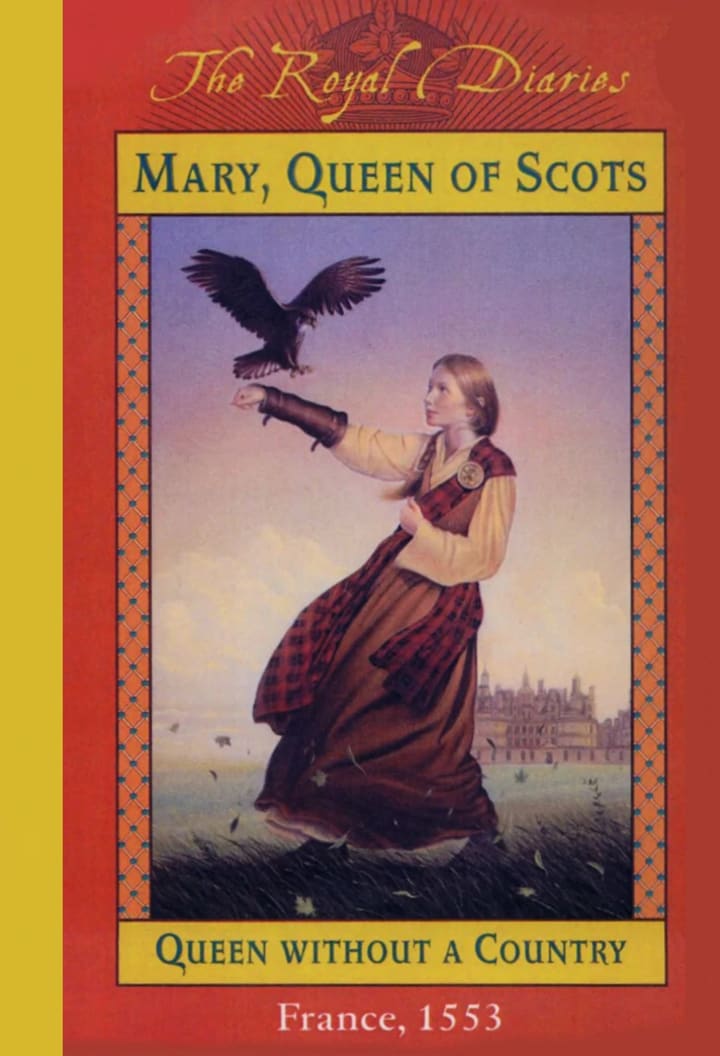
2. Mary, Queen of Scots: Queen Without a Country, France, 1553 by Kathryn Lasky (2002)
Perhaps it's my leftover teenage nostalgia for the hit CW series Reign that led to such fondness for this book. More likely, it's that when Kathryn Lasky is good, she's good. She does an excellent job of describing nature, heightened emotions, and hunger beyond the physical. I should note is that this book is a bit racier than others. Adultery is openly discussed, Mary talks about seeing hickeys on one of her servants, and there's a sexual assault plotline with Mary's friend and their music teacher. No description of Mary, Queen of Scots, would be complete without mentioning Mary's sexual awakening. It's subtle enough for kids, but I am not a kid, and my eyebrows shot off my forehead so fast they joined Elon Musk in space. Mary feels nothing for her sickly fiancé, to whom she's been betrothed since birth. However, She does feel something for one of her Scottish guards. The whole relationship I can only describe as Period Piece Horny. Imagine Daniel Day-Lewis taking off Michelle Pfeiffer's glove in The Age of Innocence but for 11-year-olds. Mary goes into a torrential rainstorm to hear her guard play bagpipes and talk about Scotland, then falls deathly ill. While raving from fever, Mary dreams that her guard teaches her how to swim by holding onto the guard's shoulders under her fiancé's jealous eye. And when she recovers from her illness, Mary worries that she called out the wrong name in her sleep. It's an absolute delight! Kids looking to learn more about Mary must look farther than the historical note. Lasky makes no mention of the Babbington Plot, her imprisonment, or her execution. That's the most baffling choice of the entire series.
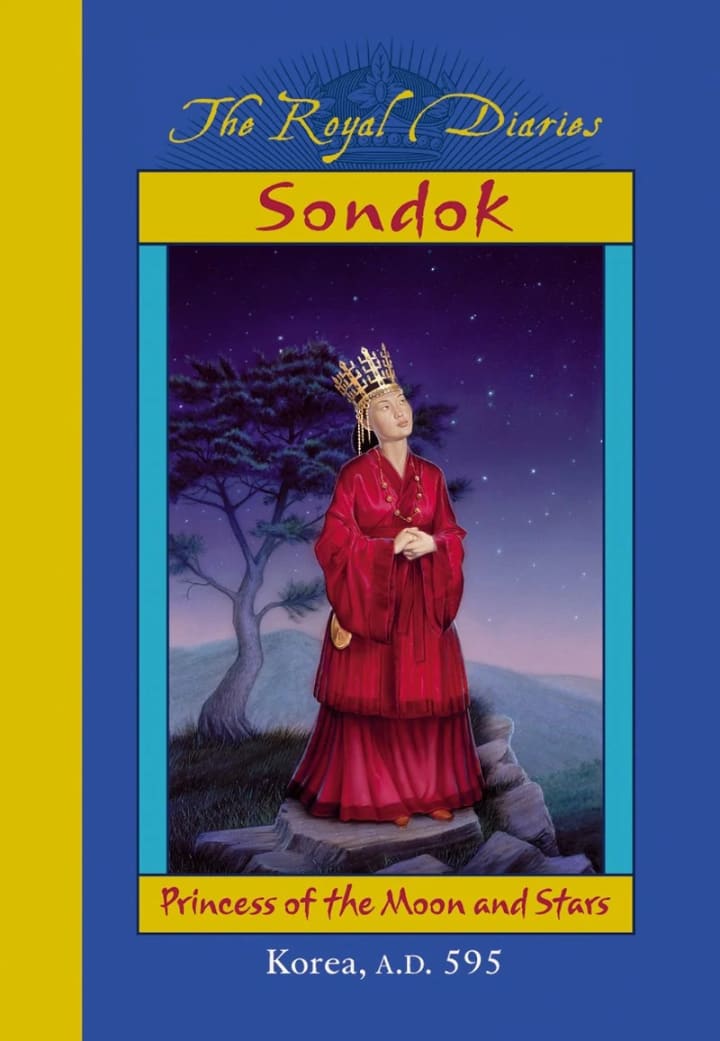
1. Sŏndŏk: Princess of the Moon and Stars, Korea, 595 A.D. by Sheri Holman (2002)
Sŏndŏk was the book I 100% did not see coming, though I wasn't sure what my expectations were. My knowledge of Korean history is woefully lacking. There's something for everyone in this book: (literal) star-crossed love; women in STEM; a villain straight out of a Disney movie; ancestor jars; religious tension; balancing gender roles. What stood out most to me (especially in contrast to Kristina) was how Sheri Holman handled Sŏndŏk's gender woes. Sŏndŏk foresees her enemies using her reign as an excuse to attack and worries how she will defend her kingdom. She learns to balance her masculine and feminine aspects rather than suffocate one to make her father happy. While Kristina's shallow gender woes manifest in Not Like Other Girls Syndrome, Sŏndŏk acknowledges that there's nothing shameful about women's work but worries about losing her "little insecure foothold [...] in the world of men". That level of insight and nuance wasn't at all what I was expecting to find in this series, but I'm delighted that I did! Beyond that, Sŏndŏk has perfect pacing, excellent tension, and a fun diary gimmick. Check Sŏndŏk out if you missed out as a kid or, like me, deal with existential despair through childhood nostalgia.
All this to say that The Royal Diaries surprised me, sometimes pleasantly, sometimes in an oh-my-god-how-was-this-published way. While the Dear America/Dear Canada books are more my lane because I prefer regular people living through major historical events, The Royal Diaries introduced me to several historical figures I would otherwise be ignorant of. Even though some of the books grew repetitive, they span an impressive breadth of topics, especially for the early 2000s. Again, all of my opinions are subjective, so I'm sorry if you're a diehard Elisabeth or Anastasia fan. Slide into my DMs for the full breakdown of the five basic plots, or to learn how I'd restructure Kaiulani.
If you liked this article, feel free to tip, and stay on the lookout for sometime next year when I read A Series of Unfortunate Events for the first time as an adult.
About the Creator
kit vaillancourt
Kit is a former english major writing about niche books, old movies, and general oddities. They dream of disappearing in the Arctic under mysterious circumstances. Follow them on Instagram or twitter @kitnotmarlowe.







Comments
There are no comments for this story
Be the first to respond and start the conversation.